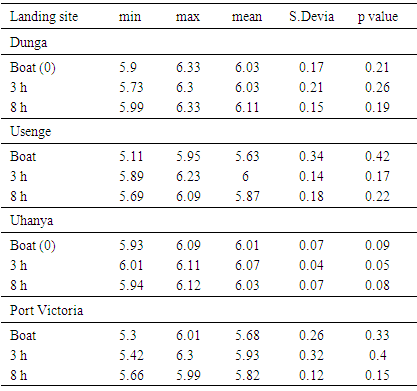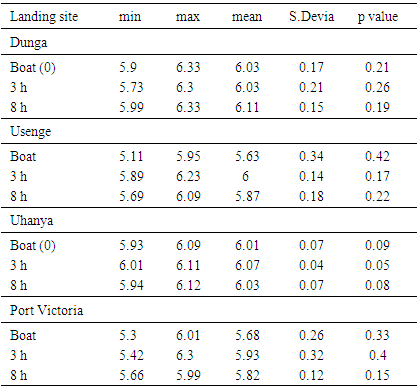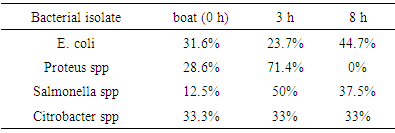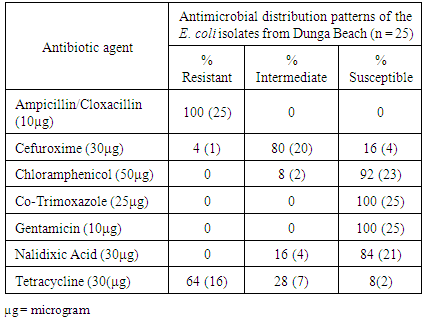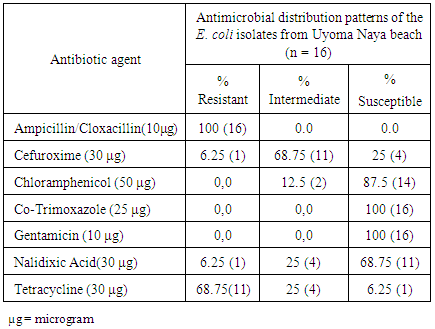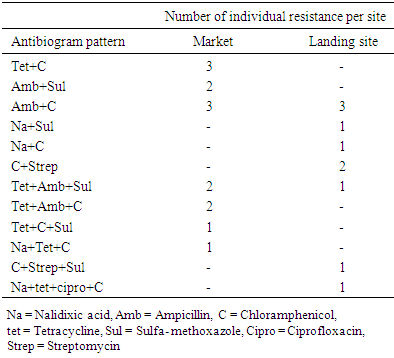| [1] | Pellegrin 1904. https://google.com. Accessed on 15 08. 2013. |
| [2] | Wanink, J.H., 1999: Prospects for the fishery on the small pelagic Rastrineobola argentea in Lake Victoria. Hydrobiol. 407: 183–189. |
| [3] | Mwebaza-Ndawula L, (1998). Distribution and abundance of zooplankton and Rastrineobola argentea (Pisces: Cyprinidae) and their trophic interactions in northern Lake Victoria, East Africa. PhD Thesis University of Vienna. |
| [4] | Wanink, J.H., and Witte, F., 2000: Rapid morphological changes following niche shift in the zooplanktivorous cyprinid Rastrineobola argentea from Lake Victoria. Neth. J. Zool. 60: 256–259. |
| [5] | FAO., 1992. The Lake Victoria Dagaa (Rastrineobola argentea) Report of the First Meeting of the Working Group on Lake Victoria Rastrineobola argentea. By P. Mannini APO Fisheries Biologist, RAF/87/099, RAF/87/099TD/38/92 (En). |
| [6] | Owaga, E. E., Onyango, C. A., and Njoroge, C. K., 2009. Effect of Selected washing Treatments and Drying Temperatures on Biochemical and Microbiological quality of Dagaa (Rastrineobola argentea). African Journal of Food Agriculture Nutrition and Development. 9 (3): 830-845. |
| [7] | EFSA., 2011. Scientific opinion and risk based control of biogenic amine formation in fermented foods. EFSA J., 9;(10): 2393. |
| [8] | Baird-Parker TC., 2000. The production of microbiologically safe and stable foods. In The Microbiological Safety and Quality of Food. Edited by Lund BM, Baird-Parker TC, Gould GW. Gaithersburg: Aspen Publishers, Inc.3-18. |
| [9] | Huis in’t Veld, J.H.J., 1996. Microbial and biochemical spoilage of foods: An overview. Int. J. Food Microbiol., 33: 1-18. |
| [10] | Amos, B., 2007. Analysis of quality deterioration at critical steps/points in fish handling in Uganda and Iceland and suggestions for improvement. United Nations University, Uganda. http://www.unuftp.is/static/fellows/document/amos 06prf.pdf. Accessed on 15/03/2014. |
| [11] | Shewan, J.M., 1961. The Microbiology of Sea-Water Fish. In: Fish as Food, Borgstrom, G. (Ed.). Academic Press, FL., pp: 487-560. |
| [12] | FAO 2005. Fisheries and Aquaculture topics. Post-harvest changes in fish. Topics Fact Sheets. Text by Lahsen Ababouch. In: FAO Fisheries and Aquaculture Department [online]. Rome. Updated 27 May 2005. |
| [13] | Fraser, O., and Sumar, S., 1998. Compositional changes and spoilage in fish-an introduction. Nutrition and Food Science. 5: 275-279. |
| [14] | Gram, L., and Dalgaard, P., 2002. Fish spoilage bacteria — problems and solutions. Current Opinion in Biotechnology. (13), 262–266. |
| [15] | Emborg, J., Laursen, B. G., and Dalgaard, P., 2005. Significant histamine formation in tuna (Thunnus albacares) at 2uC–effect of vacuum- and modified atmosphere – packaging on psychrotolerant bacteria. Int J Food Microbiol 101, 263–279. |
| [16] | Dalgaard, P., Madsen, H.L., Samieian, N., and Emborg, J., 2006. Biogenic amine formation and microbial spoilage in chilled gar fish (Belone belone)-effect of modified atmosphere packaging and previous from storage. Journal of Applied Microbiology. 101: 80-89. |
| [17] | Engvang, K., and Nielsen, H.H., 2001. Proteolysis in fresh and cold-smoked Salmon during cold storage: Effects of storage time and smoking process. J. Food Biochem., 25: 379-395. |
| [18] | Lin, T.M., and Park, J.W., 1996. “Protein solubility in Pacific whiting affected by by proteolysis during storage”, J. Food Sci., 61(3):536-540. |
| [19] | Martinez, A. and A. Gildberg, 1988. Autolytic degradation of belly tissue in anchovy (Engraulis encrasicholus). Int. J. Food Sci. Technol., 23: 185-194. |
| [20] | KNBS 2010. |
| [21] | Howard G.W., 1998. Large Lakes and Ecosystem management with reference to Lake Victoria. Water Hyacinth, Nile Perch and Pollution: issues for Ecosystem Management in Lake Victiria; in Proceedings of a workshop on “Prospects for Sustainable Managemet in Lake Victoria” Mwanza, Tanzania, 10 – 12 June, 1998. |
| [22] | FDA’s Bacteriological Analytical Manual 2007 online http:// http://www.fda.gov/FoodScienceResearch/LaboratoryMethods/ucm2006949.htm-Accessed on 20/08/2013. |
| [23] | Cravene, E. S., Lillard, H. S., and Mecuri, A. J., 1979. Survival of Clostridium perfringens during preparation of precooked chicken parts .J. food Tech. 38:505-508. |
| [24] | Clinical and Laboratory Standards Institute 2011. M100-S21 (M2). Disk Diffusion Supplemental Tables, CLSI, Wayne Pa |
| [25] | Abila, R.O., and Jensen, G.K., 1997. From local to global markets: The fish export and fish meal industries of Lake Victoria - structure, strategies and socio-economic impacts in Kenya. IUCN Eastern Africa Programme - Socio-economics of the Lake Victoria Fisheries. 2:20-25. |
| [26] | Mahmoud, K.Z., Edens, F.W., Eisen, E.J., and Havenstein, G.B., 2004. Ascorbic acid decreases heat shock protein 70 and plasma corticosterone response in broilers (Gallus gallus domesticus) subjected to cyclic heat stress. Comp. Biochem. Physiol. 137:35–42. |
| [27] | Chytiri, S., Chouliara, I., Savvaidis, I.N. and Kontominas, M.G. 2004. Microbiological, chemical and sensory assessment of iced whole and filleted aquacultured rainbow trout. Food Microbiology, 21: 157-165. |
| [28] | Ssali, W., and Masette, M., 2001. Post-harvest fisheries. In Mukiibi, J. K. (ed) 2001. Agriculture in Uganda, Livestock and fisheries, Vol. iv. Kampala Fountain Publishers. |
| [29] | Remigiusz, P., Miroslaw, M., Artur, J., Jacek, O., 2012. Microbial and Marine biotixins contamination of raw bivalve molluscs commercially available in Poland. Bulletin of the Veterinary Institute in Pulawy, 56: 563-568. |
| [30] | Ogonda, L.A., Muge, E.K., Mulaa, F.J., and Mbatia, B. N., 2014. Proximate composition of Rastrineobola argentea (Dagaa) of Lake Victoria-Kenya. African Journal of Biochemistry Research, 8; (1): 1-6. |
| [31] | Onyuka, J.H., Kakai, R., Ofulla, A.V.O., 2014. Bacterial contamination dynamics and fungal contamination levels of fish Rasterineobola argentea and Oreochromis niloticus from Lake Victoria Basin of Kenya. The Journal of Food Technology. Phototon, 106;179-188. |
| [32] | Kenya Bureau of Standards (KeBS). Specification for dried Rastrineobola argentea (omena dagaa): KS 05- 1470:1998. |
| [33] | East African Standard 2014. Dried fish Rastrineobola argentea- Specification. DEAS 826:2014. ICS 67.120.30. |
| [34] | Momba, M.N.B., Tyafa, Z., Makala, N., Brouckaert, B.M., and Obi, C.L., 2006. Safe drinking water still a dream in rural areas of South Africa. Case Study: The Eastern Cape Province. Water SA 32 (5): 715-720. |
| [35] | September, S.M., Burke, L., ELS, F.A., Venter, S.N., Brozel, V.S., Franck, M., Swart, R., Genture, B., Jagals, P., NTshewra, J., Nala, N.P., and Jagals, C., 2006. Prevalence, survival and growth of bacterial pathogens in biofilms in drinking water distribution system. WRC (SA) Report No. 1276/1/06. |
| [36] | Jay, J.M., (ed) 1992. Modern food microbiology, 4th edition, Chapman and Hall publishers, London. Pp413 – 433. |
| [37] | Mwambazi, V.C., 2005. Post-harvest fish technology in Zambia.http://www.fao.org//docrep/005/t0606b/t0606b14.htm Accessed on 14/11/2013. |
| [38] | Olsen, A.R., and Hammack, T.S., 2000. Isolation of Salmonella spp.from the housefly, Musca domestica L., and the damp fly, Hydrotea aenescens, at caged layer houses. Journal of Food Protection. 63: 958-960. |
| [39] | Urban, J.E., and Broce, A., 2000. Killing of flies in electrocuting insects traps releases bacteria and viruses. Current Microbiogy. 41: 267-270. |
| [40] | Geldreichi, E.E., and Claeke, N.A., 1966. Bacterial pollution indicators in the intestinal tract of fresh water fish. Applied Microbiology. 14: 429-437. |
| [41] | Kaneko S (1971). Microbiological study of fresh fish. New Food Industry, 13: 76-80. |
| [42] | Ghaly, A.E., Dave, D., Budge, S. and Brooks, M.S. 2010. Fish spoilage mechanisms and preservation techniques: review. American Journal of Applied Sciences 7(7):859-877. |
| [43] | Evenson, M.L., Hinds, M.W., Bernstein, R.S., and Bergdoll, M.S., 1988. Estimation of human dose of staphylococcal enterotoxin A from a large outbreak of staphylococcal food poisoning involving chocolate milk. Int. J. Food Microbiol. 7: 311-316. |
| [44] | Jablonski, L.M., and Bohach, G. A., 2001. Staphylococcus aureus. In M. P. Doyle, L. Beuchat, & T. Montville (Eds.), Food microbiology: fundamentals & frontiers (2nd ed., pp. 411–433). Washington DC: ASM Press. Washington DC. 411-433. |
| [45] | Jensen, E.G., 1997. Rich Fisheries—Poor Fisher Folk: Some preliminary observations about the effect of trade and aids in the Lake Victoria fisheries, IUCN East African Program, Socio-economics of the Lake Victoria/ishcries report No.1. The World Conservation Union, Nairobi, Kenya. |
| [46] | Marin, M.E., Rosa, M. C. L., and Cornejo, I., 1992. Enterotoxicity of Staphylococcus strains isolated from Spanish dry-cured hams. Applied and Environmental Microbiology, 58; (2): 1067–1069. |
| [47] | Wekell, M.M., Manger, R., Kolburn, K., Adams, A., and Hill, W., 1994. Microbiological quality of seafoods: Virus, bacteria and parasites. In: Shahidi F and Botta RJ (eds). Seafood-Chemistry, processing technology and quality. Chapter 11 Chapman & Hall. Glasgow 220-232 rp. |
| [48] | Gupte, S., 2006. The short Textbook of Medical Microbiology, (9th edition). Jayppee Brothers Medical Publishers (P) Ltd. New Delhi India, pp164 and 209. |
| [49] | Huss, H. H., Ababouch, L., and Gram, L., 2003. Assessment and management of seafood safety and quality. FAO Fisheries technical paper 444.www.fao.org/docrep/006/y4743e/y4743e00.htm. |
| [50] | Martinez-Urtaza, J., and Liebana, E., 2005a. Investigation of clonal distribution and persistence of Salmonella Senftenberg in the marine environment and identification of potential sources of contamination. FEMS Microbiology and Ecology 52 (2): 255-263. |
| [51] | Martinez-Urtaza, J., and Liebana, E., 2005b. Use of pulsed-field gel electrophoresis to characterize the genetic diversity and clonal persistence of Salmonella Senftenberg in mussel processing facilities. International Journal of Food Microbiology 105 (2): 153-163. |
| [52] | Worden, A., Seidel, M., Smriga, S., Wick, A., and Malfatti, F., 2006. Trophic regulation of Vibrio cholerae in costal marine waters. Environmental Microbiology. 8; 21-29. |
| [53] | Yagoub, S.O., (2009). Isolation of Enterobactericeae and Pseudomonas spp from raw fish sold in fish market in Khatoum state. Journal of Bacteriology Research.2009. 1(7):085-088. |
| [54] | FAO., 2010. Fisheries and aquaculture topics: Food security and fisheries. Topics Facts Sheets. Text by Peter Manning, FAO Fisheries and Aquacuture Department, Rome. |
| [55] | Onyango, M.D., Wandili, S., Kakai, R., and Waindi, E.N., 2009. Isolation of Salmonella and Shigella from fish harvested from Winam Gulf of Lake Victoria. Journ.. of Inf. in Dev. Count. 3(2):99-104. |
| [56] | Sifuna, A.W., Njagi, E.N.M., Okemo, P., Munyalo, A., and Orinda, G.O., 2008. Microbiology quality and safety of Rastrineobola argentea retailed in Kisumu town markets, Kenya. East Africa Medical Journ. 85(10):509-13. |
| [57] | Ogwan’g, V. O., Muchiri, M., and Thakor, P., 2005. Investigation of bacteriological quality of Smoked fish. In: Knowledge and experiences gained from managing The Lake Victoria Ecosystem, a publication of the Lake Victoria Environmental Management Project (LVEMP). pp. 552 –569. |
| [58] | Dike-Ndudim, J.N., Egbuobi, R.C., Onyeneke, E.N., Uduji, H.I., Nwagbaraocha, M.A., Ogamaka, I.A., Okorie, H.M., Egbuobi, L.N., and Opara A.U., 2014. Microbial status of smoked Scombia scombia sold in Owerri, Imo stae, Nigeria. Africa Journal of Clinical and Experimental Microbiology. 15 (1); 1322. |

 Abstract
Abstract Reference
Reference Full-Text PDF
Full-Text PDF Full-text HTML
Full-text HTML
